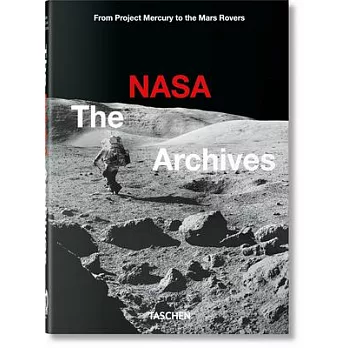1958年10月1日,為應對蘇聯發射的人造衛星,世界上第一個民間航天局正式運作。在接下來的十年內,這個「國家航空暨太空總署」,也就是一般大眾稱之為「NASA」的組織,從研究小型火箭,進而成為最先進技術和材料的開發研究基地。不僅帶領人類成功登陸月球,同時也成功派遣機器人至金星、火星等球上搜集資料回傳地球。尤其是阿波羅計畫,更是奠定了NASA在全球航太研究中的地位。
綜觀NASA六十年來的歷史,照片一直以來都扮演一個重要的資訊傳遞角色。試問,誰沒看過哈伯望遠鏡中所回傳的宇宙照片,或是火星探測器回傳的高清火星全景圖呢?又有誰能忘記當人類第一次在月球上踩下第一步的樣貌呢?
本書收錄了幾百張具有歷史意義的珍貴照片,以及最新科技所偵測回傳的各種太空圖片或資料,並由科學專業相關學者、記者們撰寫文案資料,讓讀者能夠清楚了解關於航太太空相關的歷史進程,以及新技術的未來展望。此外,除了美國太空計畫的相關歷史外,透過本書,也希望能讓讀者更清楚了解,為何人類需要探索外太空事物,而接下來的歲月中,人類又將肩負怎樣的華麗冒險。
On October 1, 1958, the world’s first civilian space agency opened for business as an emergency response to the Soviet Union’s launch of Sputnik a year earlier. Within a decade, the National Aeronautics and Space Administration, universally known as NASA, had evolved from modest research teams experimenting with small converted rockets into one of the greatest technological and managerial enterprises ever known, capable of sending people to the Moon aboard gigantic rockets and of dispatching robot explorers to Venus, Mars, and worlds far beyond. In spite of occasional, tragic setbacks in NASA’s history, the Apollo lunar landing project remains a byword for American ingenuity; the winged space shuttles spearheaded the International Space Station and a dazzling array of astronomical satellites and robotic landers, and Earth observation programs have transformed our understanding of the cosmos and our home world’s fragile place within it.
Throughout NASA’s 60-year history, images have played a central role. Who today is not familiar with the Hubble Space Telescope’s mesmerizing views of the universe or the pin-sharp panoramas of Mars from NASA’s surface rovers? And who could forget the photographs of the first men walking on the Moon?
This compact edition is derived from our XL edition, which was researched in collaboration with NASA, and gathers hundreds of historic photographs and rare concept renderings, scanned and remastered using the latest technology. Texts by science and technology journalist Piers Bizony, former NASA chief historian Roger Launius, and best-selling Apollo historian Andrew Chaikin round out this comprehensive exploration of NASA, from its earliest days to its current development of new space systems for the future.
The NASA Archives is more than just a fascinating pictorial history of the U.S. space program. It is also a profound meditation on why we choose to explore space and how we will carry on this grandest of all adventures in the years to come.



 天天爆殺
天天爆殺  今日66折
今日66折 































 博客來
博客來 博客來
博客來 博客來
博客來 博客來
博客來 博客來
博客來